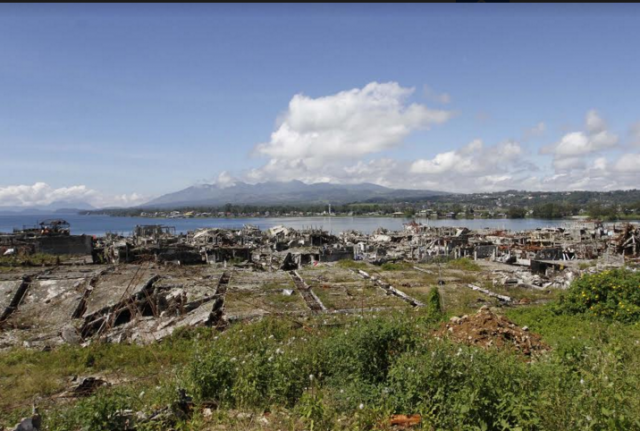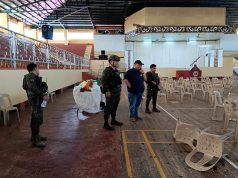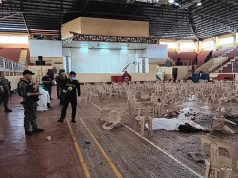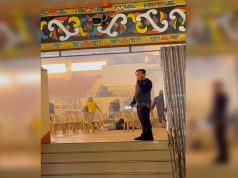
MANILA, Philippines — Marawi residents displaced by the fighting between government forces and the Maute Group last year will only be allowed to return to ground zero and stay there for a week to ten days around the first week of April.
This is because the Armed Forces of the Philippines (AFP) is still conducting a “massive recovery” of unexploded ammunition in the 250-hectare area composed of 24 barangays that used to be home to 11,000 families before Islamist extremists carried out the siege on the Lanao del Sur capital in May last year.
Housing and Urban Development Coordinating Council (HUDCC) chairperson Eduardo del Rosario, who also heads Task Force Bangon Marawi, said on Friday during a press conference in Malacañang that there might still be unexploded bombs and improvised explosive devices left by Maute in the former battleground.
Del Rosario said he was able to witness the AFP’s operations, which would take time as recovering a 500-pounder bomb for instance takes around four days to a week.
“‘Yong 500-pounder nasa ilalim ng lupa, about nine meters below (The 500-pounder is under the surface, about nine meters below),” he said.
To emphasize his point, del Rosario cited that one explosion had a coverage of 1.3 kilometers.
He said the military assured him that its clearing operations would be finished on the first week of April.
Del Rosario is allotting a week to ten days for the residents to return to their homes so they could recover their personal belongings.
After that, groundbreaking for the rehabilitation of ground zero will begin, according to the HUDCC chief.
He said the government’s chosen developer would start the development by the third week of April. Total rehabilitation is expected to take about four years, with the completion date pegged at around December 2021.
By that time, there will already be basic facilities like water, power, and telecommunications in the most affected area.
Del Rosario added that residents would have to sign a waiver before they enter ground zero, which states that it will not be the responsibility of the local government or Task Force Marawi if the lives of locals are put in danger if they get inside the former battle site.
“Kailangan namin ‘yon dahil ang gusto namin talaga, hindi na sila babalik (We need that because what we really want is for them to no longer return there). But because of the tremendous pressure ng 11,000 residents who want to see, we will allow it, provided they issue a waiver,” Del Rosario explained.
He reminded the public that 90 to 100 percent of the buildings were destroyed in the fighting, with the debris estimated to be as heavy as three million tons.
There were those saying it will take two to three years just to clear the debris, but Del Rosario cited “big developers” as saying that they could accomplish this in less than a year.
The HUDCC chief added that his office and the task force were conducting dialogues with local leaders and businesspersons to disseminate the proper information, and dispel speculations among residents as to the reasons why they are not yet allowed inside the most affected area.
Who is qualified for temporary shelter?
Also, the Bangon Marawi chairperson confirmed that after the government turned over 500 temporary shelter units in Brgy. Sagonsongan, Marawi City, in December last year, beneficiaries were not able to immediately move in.
He said this was because power and water line connections had not yet been activated last December, prompting the government to postpone the residents’ transfer to the units this month.
Last January 20, an initial 150 inhabitants had already moved in and another 250 residents are expected to transfer to the shelters on Tuesday,January 30, according to Del Rosario.
Every ten days after that, 200 units will be given to validated recipients.
The HUDCC chief said 5,000 to 6,000 temporary shelter units will be built in all. These will be allocated for the poor residents of the 24 barangays in the most affected area, whose homes had been burned or destroyed because of the war.
Del Rosario said 70 percent of the temporary shelter units would be given to residents who are currently in evacuation centers, and 30 percent would be awarded to home-based evacuees.
The local government unit is in charge of validating the beneficiaries, and the barangay captain must be able to attest to the beneficiaries’ circumstances, according to the HUDCC chair.
The government will also construct 3,000 permanent housing units that will go to those who will be residing in the temporary shelter units and have nowhere else to go, as opposed to those in temporary shelter units who will be building their own homes.
Will gov’t pay for stolen goods?
Another common question from Marawi residents is whether their stolen items and appliances will be paid for by the government.
Del Rosario said the government would not do so because it would be very difficult to validate whether indeed persons lost their belongings due to clashes.
He added that in similar incidents, no country in the world gives assistance to people who claim that their properties were stolen during a war.
WATCH THE PRESS CONFERENCE HERE:








